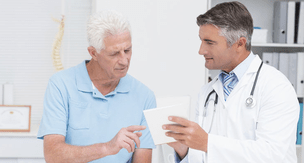
Chronic prostatitis is an inflammatory disease characterized by lesions of the prostate gland and severe urodynamic disorders. One of the causes of chronic inflammation of the prostate is improper or untimely treatment in the acute stage, when the desquamation and proliferation of the glandular epithelium are reversible and are successfully corrected with medication within 2-3 weeks.
The treatment of chronic prostatitis includes massive antibacterial therapy aimed at eliminating the infectious pathogen, a set of measures to increase the body's immunoresistance, physiotherapy methods, heat therapy. Psychocorrection can also be included in the treatment regimen, as neurasthenic and neurosis-like conditions are often observed in men with long-term and recurrent prostatitis.
Why does inflammation become chronic?
Knowledge of the causes of chronic inflammation of the prostate is necessary to prevent exacerbations and improve the quality of life of patients. There are a number of factors that can affect the functional state of the glandular (glandular) tissue of the prostate gland and cause its inflammation, which is based on desquamation and proliferation of epithelial cells.
The main cause of chronic prostatitis in men is the extensive contamination of the mucous membranes of the genitourinary system by pathogenic microorganisms. In the vast majority of cases (over 80%) of infectious prostatitis, gram-negative and gram-positive bacteria become the cause of infection: enterobacteria (in particular, Escherichia coli), gonococci, staphylococci. Less often, the infectious and inflammatory process takes place against the background of infection with viruses, fungi and protozoa, but such forms of prostatitis are treated quite successfully during the acute period and rarely give relapses, subject to proper and timely therapy.
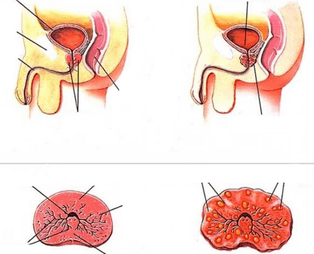
It should also be borne in mind that a single acute urinary tract infection is sufficient for the development of chronic aseptic prostatitis, therefore personal hygiene, condom use during sexual intercourse and timely treatment of urinary tract diseasespathways are important for the prevention of this disease in men. Medicine knows cases of hematogenous (through systemic circulation) infection of the prostate in chronic sinusitis, tonsillitis and other diseases that contribute to the active growth of pathogenic flora, therefore the rehabilitation of foci of chronic infection is an important stage in complex treatment of long-term or long-term inflammation. of the prostate.
The negative factors that can cause exacerbation of prostatitis (including non-infectious course) are:
- urinary tract injuries and operations of the genitourinary system;
- regular or severe hypothermia of the pelvic organs (swimming in open tanks during periods when the water is not warm enough or the weather is cool outside, work in refrigerators and freezers, etc. );
- hypodynamia caused by sedentary work and insufficient physical activity of the man (sedentary lifestyle is one of the main factors for the development of chronic cognitive prostatitis);
- bad habits in which the absorption of the most important macro- and microelements determining the chemical composition and rheological properties of prostate secretion (zinc, chromium, selenium, manganese) is delayed or disturbed;
- intimate disorders (frequent masturbation, irregular sexual intercourse, long periods of abstinence, frequent arousal that does not end with sexual intercourse);
- overweight;
- eating disorder (increased consumption of spicy, overly salty, smoked and fatty foods).
Pay attention! Urologists note that the leading pathogenetic factor for the development of chronic inflammation of the prostate is posterior urethritis. It has also been noted that inflammatory changes in the prostate in men appear in the first months after a gonorrhea infection.
Treatment of chronic prostatitis with drugs
Treatment of chronic prostatitis with drugs is aimed only at suppressing acute symptoms during exacerbation and destruction of the infection, but drugs can not be used as the only means (the effectiveness of such treatment will not exceed 36%, according to e-r Pecherski).
A complete regimen of drug treatment for chronic or recurrent prostate inflammation, which is used today as a standard in uncomplicated disease, is presented in the table below.
Table. Preparations for complex treatment of chronic prostatitis.
| Pharmacological group | Goal |
|---|---|
| Macrolide antibiotics, semisynthetic penicillins and third generation cephalosporins with a broad spectrum of antibacterial activity. | Elimination (destruction) of pathogenic bacteria - causes of infectious prostatitis, urethritis, cystitis and other urinary tract infections. |
| Antimicrobial and antiprotozoal agents. | Treatment of infections caused by pathogenic microbes and protozoa. |
| Non-steroidal anti-inflammatory drugs (preferably in the form of rectal suppositories). | Reduces inflammation in prostate tissue, relieves pain in the perineum, intergluteal space, sacrum and groin. |
| Antiseptics in the form of rectal suppositories. | Rehabilitation of rectal mucosa and prevention of its infection with prolonged prostatitis. |
| Alpha blockers. | Normalize urination, restore daily urine output. |
| Correctors for microcirculation. | Elimination of congestion in the vessels of the pelvis, restoration of normal blood and lymph flow. |
| Correctors of urodynamics (agents affecting metabolism in prostate tissues). | Improving the metabolic and metabolic processes in the tissues of the prostate gland and its nutrition. |
| Power regulators. | Complex treatment of erectile dysfunction, improving the chemical composition, viscosity and fluid of semen, increasing sperm activity (the use of drugs from this group is indicated for patients whose prostatitis is complicated by autoimmune infertility). |
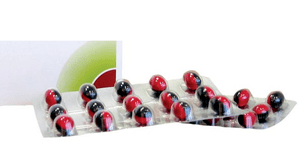
The duration of antibiotic treatment is at least 4-6 weeks. Under no circumstances should you take antibacterial drugs without a prescription, as the leading factor in choosing therapy is the results of microscopic examination of prostate secretions and fluids spontaneously released as a result of prostate massage. Some antibiotics, for example, penicillins (a combination of amoxicillin with clavulanic acid) are reserve drugs and their improper use can lead not only to the absence of clinically significant effect and progression of the pathology, but also to the development of superinfection.
Important! In some cases, men with chronic prostatitis need psychocorrection, especially if the pain syndrome is combined with behavioral changes, increased anxiety, irritability and neurasthenia. Antidepressants with selective serotonin reuptake inhibition are used to suppress these symptoms.
Physiotherapy
Heat therapy is the main method of treating chronic prostatitis outside periods of exacerbation (after regression of acute symptoms). Heat therapy refers to the methods of physiotherapy and represents a dosed effect of heat on the affected area. The benefits of thermal procedures are in the normalization of blood circulation, relief of inflammatory processes, reduction of chronic pelvic pain, which is one of the main clinical manifestations of chronic prostatitis, which reduces the quality of life of men. The heat also improves the penetration of therapeutic substances into the prostate tissue, so in some cases physiotherapy is used to increase the effectiveness of drug therapy (eg electrophoresis with antibiotics). For men at high risk of thrombus formation, warming is prescribed for prophylaxis, as heat has a moderate resorbing effect.
There are a large number of methods for thermal exposure to the body and the choice of a specific method of treatment should be made by a doctor, taking into account the clinical picture, form and stage of the disease, the age of the man and his individual tolerance. The most effective methods of heat therapy for prostatitis are: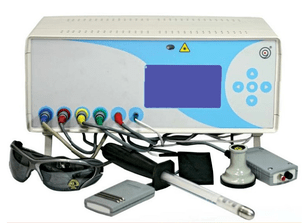
- thermal applications with minerals (ozokerite, paraffin, bischofite), salt or sand;
- electric heating pads;
- deep heating of high-strength tissues for direct effect on blood vessels and nerve endings (diathermy);
- exposure to high-frequency alternating magnetic fields in order to eliminate pain, relieve inflammation and eliminate neurosis-like manifestations (inductothermy);
- ultrasound therapy (promotes resorption of abscesses and healing of formed scars);
- electrophoresis with insertion of electrodes into the rectum;
- exposure of prostate tissue by high frequency pulse currents (darsonvalization).
In some physiotherapy clinics, chronic inflammation of the prostate is treated with hot mud applications ("mud panties"). Such procedures have a positive effect not only on blood and lymph circulation, but also on the production of prostate secretion, as well as tissue nutrition of the inflamed organ. In some cases, the mud is injected directly into the rectum in the form of tampons, as with this method of administration it is possible to quickly achieve a therapeutic effect and a positive response to therapy.
Other treatments
The scheme of complex treatment, in addition to drug and heat therapy, is complemented by various procedures that the doctor prescribes, taking into account the specifics of the pathology in each case.
Prostate massage
This is one of the main methods of treatment of chronic inflammation of the prostate gland, which is recommended for use in almost 90% of cases (in the absence of contraindications). Massage is a finger effect on the prostate in order to stimulate the outflow of secretory fluid. The duration of the procedure is usually about 1-2 minutes. The criterion for sufficient effect is the complete emptying of the prostate glands, which the patient feels as relief (of which he must inform the doctor).
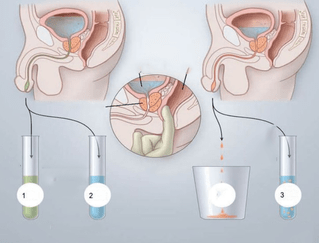
The benefits of massage are determined by the therapeutic effect that can be achieved after a course of treatment (8-12 procedures). With an uncomplicated course, these are:
- normalization of muscle tone;
- improving blood circulation in the vessels of the prostate (therefore accelerates the transport of drugs into the tissues of the affected organ and increases the effectiveness of therapy);
- restoration of secretory patency;
- normalization of blood and lymph flow from the prostate gland (especially significant in cognitive prostatitis).
The procedure is contraindicated during the acute period due to the high risk of spreading infection to surrounding tissues and organs (hematogenous infection), other infectious diseases of the genitourinary system, the presence of cysts or stones in the prostate. Prostate massage is not prescribed to patients diagnosed with tuberculous organ damage, adenoma or other neoplastic diseases (including prostate cancer lesions). In the presence of diseases of the rectum (hemorrhoids, anal fissure, proctitis, paraproctitis), massage can cause complications and provoke a recurrence of the underlying disease.
Important! Studies show that almost 42% of men refuse prostate massage due to the increased psychological discomfort associated with the peculiarities of this procedure. The physician's work with such patients should include detailed information on the consequences of refusal of treatment and possible complications, in particular infertility and persistent sexual dysfunction. In some cases, it may be advisable to prescribe a mild sedative a few days before starting treatment.
Hot enemas
Hot enemas are home treatments for chronic prostatitis, but urologists recognize their effectiveness and recommend them for faster and more effective treatment of prostatitis. The water temperature for these enemas should be around 42 ° C. Before the procedure it is necessary to clean the intestines with a regular enema or laxatives. The volume of one enema is from 150 to 300 ml. It is recommended that the bowel be emptied 30-50 minutes after administration of the solution.
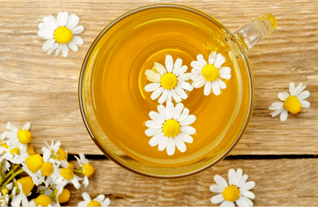
Prescriptions for chronic inflammation of the prostate are listed below.
- Dissolve 10 drops of iodine and about 20 ml of chlorhexidine in 200 ml of water. Apply at bedtime for 15 days.
- A decoction of chamomile, St. John's wort or calendula should be introduced into the rectum (about 250 ml) and then kept for 1 hour. The procedure is repeated once a day for 2 weeks.
- Sea buckthorn oil (40-50 ml) is heated to 40 ° C and introduced into the rectum for 20-30 minutes. The course of treatment is 10-15 days. The procedure is best done before bedtime.
- In case of severe pain syndrome, which significantly limits the patient's mobility and worsens his quality of life, microclysters with novocaine can be used. Dissolve 2 ampoules of 2% novocaine solution in 180 ml of steep chamomile decoction. Hold for at least 50 minutes. Repeat daily for 1 week.
Anti-inflammatory drugs, antiseptics, antibiotics can also be used for microclysters. The use of these drugs is permissible with the permission of a physician strictly in the specified dosage.
Treatment of chronic prostatitis: step by step instructions
The use of various treatment methods is not enough to completely get rid of chronic prostatitis. If a man does not follow his diet and does not change his lifestyle, exacerbations will regularly occur, leading to irreversible changes in the structure and functional activity of the prostate glands and constant dysuric and sexual disorders. To increase the effectiveness of treatment and the duration of remission, you should adhere to the recommendations set out in the instructions below for patients with chronic prostatitis.

- Step 1. If a man is diagnosed with chronic prostatitis, he should start by adjusting his diet. It is necessary to exclude from the menu foods high in fat, salt and spices. Fat raises blood cholesterol levels, and salt promotes fluid retention and swelling in prostate tissue. Spices (such as various chemical additives) irritate the mucous membranes of the urinary tract, provoking an exacerbation of existing symptoms.
- Step 2. It is also necessary to completely eliminate alcoholic beverages, as they slow down the absorption of nutrients, disrupt blood and lymph circulation and adversely affect the metabolism in the prostate. If a man suffers from tobacco addiction, measures must be taken to get rid of this habit (toxic substances in tobacco smoke disrupt the viscosity and fluid of prostate secretion and change its chemical composition).
- Step 3. Overweight men should consult an endocrinologist and dietitian for a complete diagnosis and correction of body weight, taking into account the identified abnormalities. Obesity is the most important factor in the development of chronic prostatitis, and an important stage in complex therapy is weight loss in patients with high BMI.
- Step 4. In order to eliminate stagnant phenomena associated with hypodynamic disorder, it is necessary to ensure an adequate level of physical activity appropriate to age and physical shape. Swimming, physiotherapy, stretching, walking are useful in prostatitis.
- Step 5. For the normal functioning of the prostate it is necessary to monitor the quality of sexual life. It is advisable to have a regular sexual partner, to avoid episodes of sexual arousal if there is no possibility of further sexual intercourse, and to check regularly for genital infections, which can also provoke an exacerbation of chronic prostatitis.
Men with recurrent prostatitis should watch for emotional stress, avoid stressful situations, and prolonged exposure to cold or drafts.
Chronic prostatitis is a disease that is difficult to treat, especially if the patient does not follow the doctor's instructions and does not approach the issues of nutrition and diet responsibly. Inflammation of the prostate is dangerous with serious complications, so you need to approach the problem comprehensively. Men with this diagnosis should understand that the pills alone are not enough to fully restore all prostate function, so you should not abandon the methods of basic therapy for chronic prostatitis suggested by your doctor, even if they cause primary psychological orphysical discomfort.































